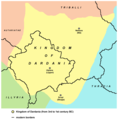Dardania
Dardania (lat. Dardania ) is a historical region in south-east Europe that stretched between the Ibar , Morava and the upper reaches of the Vardar . It encompassed today's territory of Kosovo and also some southern areas of today's Serbia and North Macedonia . The region was named after one of the Illyrian tribes, the Dardans , who mixed with Thracian peoples to the east .
history
In ancient times, the Dardanians often undertook raids into the southern Macedonian area , but were killed in 335 BC. Subjugated by Macedonia. 279 BC Celtic tribes expelled from Macedonia moved into the land of the Dardans. Around 250 BC The Dardans spread to the Adriatic Sea , with their sharpest opponents being the Illyrian Ardiaioi (German Ardieans ). 229 BC The Dardans defeated the Macedonian king Demetrios II. Under his son Philip V , Dardans were settled around the Macedonian cities of Pella , Edessa and Beroia .
In the middle of the 1st century, the area came under the rule of the Roman Empire and formed part of the province of Moesia (later Moesia superior ). During this time, some veteran colonies were established in Dardania, the city of Scupi developed into the regional center and Emperor Trajan founded the colony Ulpiana . In the course of the reforms of Diocletian , the Roman province of Dardania was founded, which included the cities of Naissus , Ulpiana, Scupi, and the Municipium Dardanorum. Prokopios of Caesarea recorded 69 fortresses in Dardania in the 6th century. In the 7th century the area was conquered by Slavs after Maurikios ' unsuccessful wars .
In the late Middle Ages , Dardania reappeared in the works of learned authors. Today the name is occasionally used by Kosovar Albanians as an alternative name for Kosovo. Before Kosovo gained independence on October 29, 2000, then President Ibrahim Rugova presented the " Dardania flag " as a draft for a possible state flag.
cards
Comparison of Dardania at the turn of the century / Kosovo
literature
- J. Szilágyi: Dardani . In: The Little Pauly . Vol. 1 (1964), col. 1386-1387.
- S. Ćirković: Dardania . In: Lexicon of the Middle Ages . 3: 571 (1986).
Individual evidence
- ↑ Arthur Evans: Ancient Illyria: An Archaeological Exploration . Ed .: Bejtullah D. Destani. 2006, ISBN 1-84511-167-2 .
Coordinates: 43 ° 19 ′ 0 ″ N , 21 ° 53 ′ 0 ″ E



